Biodiversity as a driver of sustainable transformation in Latin America and the Caribbean
Work area(s)
Biodiversity “silently” sustains humanity’s well-being
Human well-being depends to a large extent on the goods and services provided by biodiversity and its ecosystems, a concept known as “nature’s contributions to people” and also as “ecosystem services” (IPBES, 2019). However, biodiversity processes are in many ways “silent” and “invisible” (hard to see), difficult to quantify at different levels (genes, species and ecosystems) and widely variable through time. This partly explains why modern human societies have not included nature as a strategic component in development planning, institutions and the market (Dasgupta, 2021).
Unlike other processes, such as ozone thinning or climate change, which may yet be reversible, the biodiversity crisis in certain places is of such a magnitude that the accumulating changes in ecosystem richness, structure and function are at potentially irreversible levels or have already reached irreversibility (IPBES, 2018 and 2019). Scientists, civil society organizations and governments have issued numerous warnings about the delay in prioritizing addressing the crisis of biodiversity loss and environmental degradation and have underscored the seriousness of its potential consequences. Inaction or insufficient action is due in part to the difficulty of implementing cross-cutting responses in a systemic manner. Although there are multiple policy instruments that address different areas of production and consumption individually, there has been a delay in the full implementation of those policies in the region (UNEP, 2020). Image 1 compares the impact of a coherent interlinked system of change to the current inertial or business-as-usual approach.
Image 1
Model of the impact of a system of coherent and interlinked changes
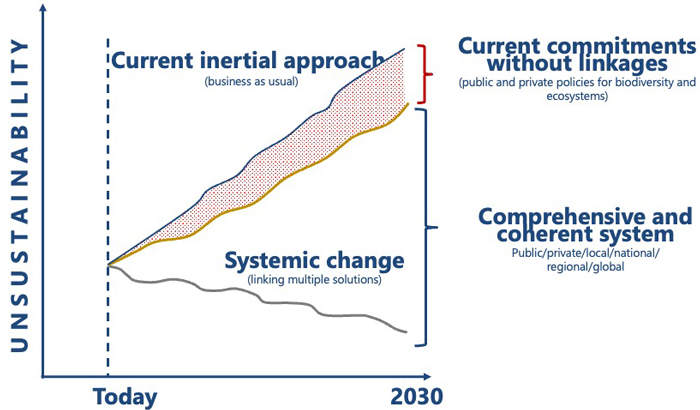
Source: Prepared by the authors, on the basis of PEW Charitable Trusts/SYSTEMIQ, Breaking the Plastic Wave: A comprehensive assessment of pathways towards stopping ocean plastic pollution, 2020. The business-as-usual trajectory reflects the current inertial approach.
Studies with different future scenarios show that there are no winners if the current inertial approach continues —not acting is therefore not an option (World Bank, 2021a). Biodiversity loss and environmental degradation is a critical issue for Latin America and the Caribbean, given the region’s dependence on its extraordinary biocultural heritage for its development. Biodiversity is a fundamental asset that represents a large portion of a country’s national wealth. For example, in 2018 it was estimated that the bioeconomy accounted for between 12.8% and 15.7% of Costa Rica’s GDP (ECLAC, 2023). At the same time, the region is facing one of the highest levels of risk in the world to its marine, terrestrial and freshwater biodiversity (ECLAC, 2022; WWF, 2020) (see image 2).
Image 2
Characteristics and challenges of Latin America and the Caribbean
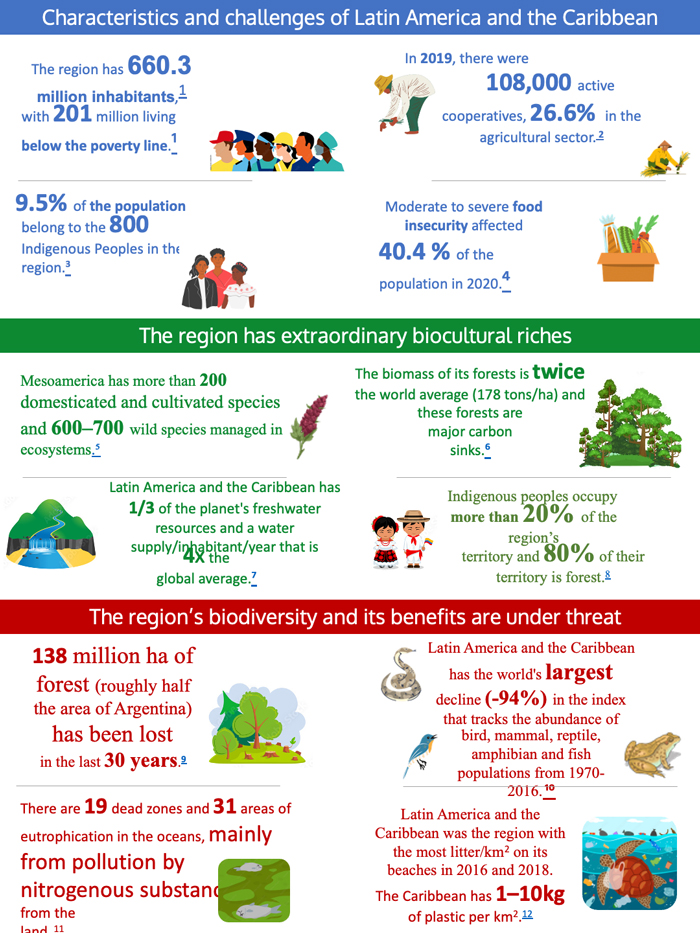
Source: Prepared by the authors (the sources can be accessed by clicking the superscript numbers).
Notas:
5. https://www.cepal.org/es/publicaciones/40299-agrobiodiversidad-agricultura-familiar-cambio-climatico
7. https://www.cepal.org/sites/default/files/news/files/informe_regional_america_latina_y_caribe.pdf
8. https://www.fao.org/documents/card/en/c/cb2953es
10. https://wwfin.awsassets.panda.org/downloads/lpr_2020_full_report.pdf
Nature provides direct and indirect benefits (such as food, fibre, cleaning the air, cycling and cleaning water, and regulating pests and zoonotic diseases), which are often key to the survival strategies and livelihoods of the most vulnerable. The poor have a disproportionate dependence on the environment for access to food, building and shelter materials, energy, medicine, and self-employment, especially in rural areas. Although such contributions of nature to people are not considered in national poverty studies or national accounts (as they are generally not traded on the market), there is evidence that they play a fundamental role in their livelihoods (UNDP, 2016; Lehm, Lara and Solares, 2017; UNEP, 2020) (see box 1). For example, a global study conducted in 2015 using household survey information identified the different types of income of rural populations, including non-cash income, such as “environmental income” from forest and non-forest extraction, and highlighted that in Latin America and the Caribbean, the latter make up 31% of total income, the highest proportion compared to other world regions, followed by Sub-Saharan Africa (29%) and East Asia and the Pacific (24%) (Noack and others, 2015).
Box 1
Nature’s contribution to well-being in Tacana I, Bolivia
A study by Lehm, Lara and Solares (2017) of the socioeconomic and environmental situation in Tacana I, a communally owned indigenous territory (tierra comunitaria de origen, TCO) in Bolivia, estimates that about 40% of income is non-monetary (products and resources used for consumption, gifts and bartering). Local activities account for nearly two-thirds of household income: timber harvesting (20.4%), fishing (16.2%), hunting (13.3%), livestock (9.9%) and agriculture (2.2%). Agricultural activities largely require a change in land use, while other activities depend on good conservation of biodiversity and its ecosystems. The deforestation rate in the community in the period 2005–2010 was 0.5%, much lower than the annual deforestation rate on neighbouring lands of 2.3%.
Based purely on cash income and the Bolivian National Institute of Statistics definition of poverty, 60.1% of households are living in extreme poverty. However, when non-cash income is included, the proportion drops significantly, to 17.6%, thanks to the fact that the community’s people live in a healthy environment that supplies many of their needs. Non-cash income also plays an important role in combating inequality because it is less concentrated than cash income.
Figure 1
Tacana I Indigenous region, Bolivia. Cash and non-cash income and their relationship with the ecosystem

Source: Lehm, Z, K Lara and T Solares, Ingresos económicos en hogares de la TCO TACANA I, La Paz, Wildlife Conservation Society (WCS)/Consejo Indígena del Pueblo Tacana (CIPTA), 2017.
The shift to sustainable trajectories cannot be put off any longer
If biodiversity is not healthy, ecosystem services start to degrade or collapse, a risk regarding which the World Economic Forum has also issued warnings. Over the last decade, the perception of risks associated with the loss of biodiversity and ecosystem services to economies, as reported in the annual The Global Risk Report, has grown substantially (image 3). Biodiversity loss was first considered a possible risk category in the 2012 report (although for the first two years it was confined to overexploitation of species), and it varied between sixth and fifteenth place in terms of impact between then and 2019. However, in the period 2020–2022, biodiversity loss has twice ranked third in terms of degree of impact, and once fourth (WEF, 2012, 2013, 2014, 2015, 2016, 2017, 2018, 2019, 2020, 2021 and 2022). As these risks have been described as systemic, almost all businesses are exposed to impacts from biodiversity loss (UNEP/Global Canopy, 2020).
Image 3
Trend in the perception of risk to the global economy from the loss of biodiversity and ecosystem services, 2012–2022
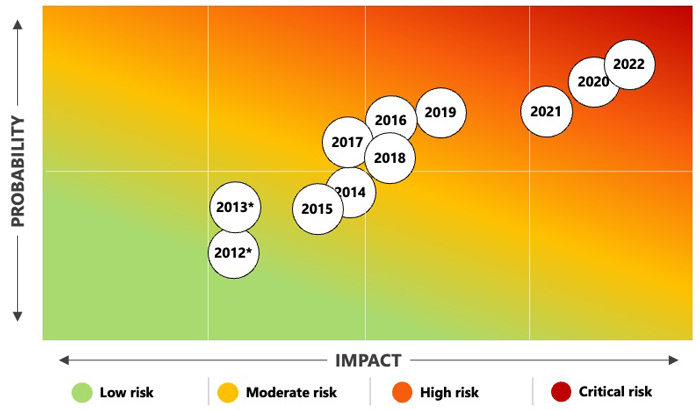
Source: Prepared by the authors, on the basis of World Economic Forum (WEF), The Global Risk Report, 2012 to 2022.
Note: * Refers only to overexploitation of species
A modelling exercise to estimate the cost of the collapse of wild pollination, marine fisheries and timber supply in native forests from 2022 to 2030 caused by the conversion of natural lands to cropland, pasture and forest plantations yielded a global real GDP loss in 2030 of between US$90 billion and US$225 billion (the variation depends on whether the associated value of carbon sequestration services is taken into account compared to a scenario with no change in nature’s services) (World Bank, 2021a). Furthermore, the authors warn that the damage will be greater if the global economy is not able to adapt quickly to the loss of ecosystem services, reinforcing the urgency of acting now. The results showed a real GDP loss for Latin America and the Caribbean of -3.3%.
Achieving significant changes through a few transformations is not a realistic prospect. It is necessary to generate coherent and coordinated systems of change among different actors and at different levels, from global through regional and subregional to national and subnational. In this regard, the United Nations has called on all stakeholders to actively participate in transforming the global system.
The Convention on Biological Diversity and the difficulties in reaching consensus agreements at the fifteenth session of the Conference of the Parties (COP 15)
The Convention on Biological Diversity (CBD), adopted at the United Nations Conference on Environment and Development in 1992, is the most comprehensive and ambitious multilateral framework focused on nature, sustainability and equity at the global level and is a reference point for the development of national and subnational biodiversity policies. All Latin American and Caribbean countries are parties to the Convention. Latin America and the Caribbean is currently second in terms of regions that have organized the Conference of the Parties (COP) the most often —four times— behind Asia and the Middle East, which together account for six. The first three CBD COPs were organized annually, between 1994 and 1996; since 1998, they have been held every two years, except for COP 15, which was postponed for two additional years owing to the COVID-19 pandemic. This is why, despite the fact that the CBD COPs started earlier (1994) than those of the United Nations Framework Convention on Climate Change, to date there have been 27 COPs on climate change and only 15 on biodiversity, which may also be one of the reasons why there is much greater awareness of the climate crisis than the biodiversity crisis.
In 2010, at COP 10 held in Aichi Prefecture, Japan, the Strategic Plan for Biodiversity 2011–2020 and the Aichi Targets were agreed upon, establishing five strategic goals to be achieved by 2020, with 20 targets and 60 sub-targets. Unfortunately, none of the targets was fully achieved, and the vast majority made insufficient progress, compromising the path towards sustainable development (CBD, 2020). It is clear that such a trajectory makes it impossible to achieve the 2050 vision of “living in harmony with nature” to which all countries committed under CBD, as well as undermining efforts to address climate change (CBD, 2020).
Since 2018, the parties had been negotiating a new framework for the current decade that would include lessons learned from the Aichi Targets and was set to be adopted at COP 15, scheduled to be held in 2020. Regrettably, the pandemic made it difficult to achieve a “growing momentum” to agree on an ambitious new global biodiversity framework. COP 15 was postponed several times during the two years of the pandemic and the four years of global consultations and discussions, mainly held online (with the drawback that all regions have different time zones), during which convergence seemed to remain elusive. The very complexity of the process —especially when the evidence points to the need for new development paradigms— and the high number of matters under negotiation (issues, levels and relevant stakeholders; for example, marine ecosystems beyond national jurisdictions, digital sequences of genetic resources, indigenous peoples and local communities, and financing, among others) put the outcome at risk. The difficulties meant that COP 15 had to be held in two parts: the first, with few face-to-face participants, in Kunming, China in October 2021; the second, with more than 3,000 delegates from some 190 countries, in Montreal, Canada, in December 2022 (CBD, 2022b). Ultimately, the parties adopted the new Kunming-Montreal Global Biodiversity Framework (see diagram 1) and several other decisions as a package.
Among the key issues that arose during the negotiations were the insufficient and ineffective disbursement of aid money and the gap between the expectations of developed nations and the capacity of developing states to implement the agreement. In spite of the challenges, the new multilateral instrument was achieved by establishing a voluntary roadmap to halt the crisis of biodiversity loss and environmental degradation. If fully and comprehensively implemented, it is expected to change the trajectory by bringing about a “transformative change” so that the health of nature can be restored in the decade 2030–2040.
Diagram 1
The overall objectives and targets of the Kunming-Montreal Global Biodiversity Framework
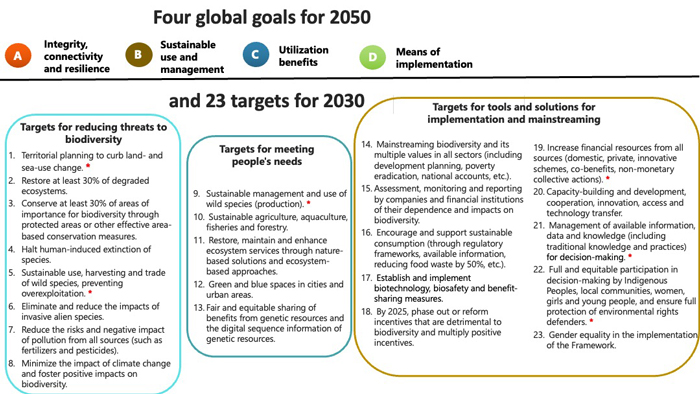
Source: Prepared by the authors.
Nota: * Target that explicitly mentions indigenous peoples and local communities (IPLCs).
Main decisions agreed at COP 15 and the new Kunming-Montreal Global Biodiversity Framework
During the fifteenth meeting of the Conference of the Parties of the Convention on Biological Diversity and those of the Cartagena Protocol on Biosafety to the Convention on Biological Diversity and the Nagoya Protocol on Access to Genetic Resources and the Fair and Equitable Sharing of Benefits Arising from their Utilization to the Convention on Biological Diversity, the 196 signatories and parties to the Convention adopted 62 decisions, including the new Kunming-Montreal Global Biodiversity Framework 2022–2030, and a set of five decisions grouped by strategic themes to facilitate their implementation, evaluation and fulfilment: (i) monitoring framework; (ii) mechanisms for planning, monitoring, reporting and review; (iii) capacity-building and development and technical and scientific cooperation; (iv) resource mobilization; and (v) digital sequence information on genetic resources. Also approved were a special trust fund for the Framework, under the responsibility of the Global Environment Facility (GEF); a new Gender Plan of Action; an updated Plan of Action on Subnational Governments, Cities and Other Local Authorities for Biodiversity under the Convention on Biological Diversity (2021–2030); and an agreement to work on a long-term strategic approach to mainstreaming biodiversity (IISD, 2022). Through four goals and 23 targets for urgent action, the Kunming-Montreal Framework commits to the protection, sustainable use and restoration of biodiversity through various mechanisms, including the sustainable use of 30% of the planet’s land and water, reducing global food waste by 50%, and generating at least US$ 272 billion annually in global funding for biodiversity by 2030, as well as the fair and equitable sharing of the benefits derived from genetic resources, among others (see diagram 1).
Taking into account the lessons learned from the Aichi Targets, special attention was given to facilitating the implementation of the Framework, with the result that 10 of the 23 targets include a set of tools and solutions for their implementation. An effort was also made to improve the goals by making them more precise and ambitious than the previous ones; however, in several instances, the language approved remains ambiguous.
The Kunming-Montreal Framework is a pioneer in recognizing the fundamental role of indigenous peoples and local communities as agents of change in the achievement of its targets; they are expressly mentioned in 7 of the 23 targets, establishing their active role in decision-making processes and the possibility of their territories being recognized in nature protection goals. The new accord also commits to protecting the customary use of natural resources, while reaffirming that no current or future rights of indigenous peoples will be diminished. The Framework recognizes and strengthens the rights-based approach (see figure 5 illustrating the dimensions of the rights-based approach), has a cross-cutting approach and a gender-specific target, and sends important signals to private actors such as large companies and investors. Furthermore, governments will have to follow up on and promote the transparency of information on the risks associated with private business activity as well as consumer access to that information (IISD, 2022).
Diagram 2
The rights-based approach to biodiversity: justice, recognition, processes and distribution
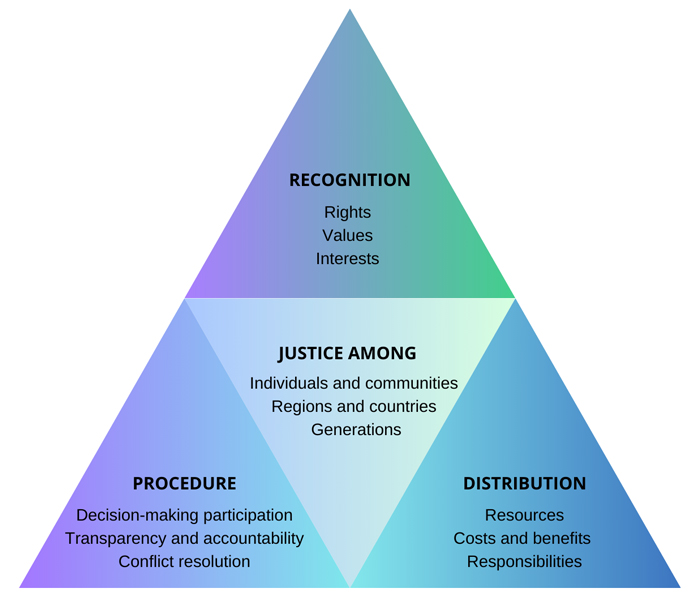
Source: Prepared by the authors on the basis of J. Bernstein and others, Strengthening Equity in the Post-2020 Global Biodiversity Framework, International Institute for Environment and Development (IIED), 2021.
Crucially, the Framework advocates for the transformative changes needed to effectively reverse biodiversity loss. Among these systemic measures are the development of integrated spatial data-driven land and marine management plans, the integration of nature’s multiple values —including the value of existing— into development planning and all aspects of human activity, and a significant increase in funding for biodiversity, including the elimination of half of subsidies that are detrimental to biodiversity by 2025 and the multiplication and scaling up of positive incentives (UNDP, 2023).
However, among their limitations, it should be borne in mind that the targets were established at the global level and the commitment made by each country or subnational government is non-binding. Therefore, it will be very difficult to have clarity as to whether the sum of individual commitments will achieve the multiple global targets and goals. In addition, for some targets, monitoring indicators have not been agreed upon, there is no globally validated methodology for defining them, or, as mentioned, the language is ambiguous.
National biodiversity strategies and action plans, which will play a key role in the implementation of the Global Biodiversity Framework, should be aligned or updated in preparation for COP 16 in 2024, in such a way that they are co-created by all sectors through an inclusive approach, enabling the establishment of communities of practice and learning at all levels and using human rights, gender and intergenerational justice approaches.
The 2022–2030 Kunming-Montreal Global Biodiversity Framework and the 2030 Agenda
The 23 targets of the Kunming-Montreal Framework are synergistic with most of the targets under the Sustainable Development Goals (SDGs) of the 2030 Agenda. The architecture of the Framework puts nature at the centre of sustainable development in a multidimensional manner, with a focus on reducing inequalities and on inclusion, a rights-based approach, peaceful and engaged societies, sustainable use, businesses, and cities and ecosystems, among others. For example, the Global Biodiversity Framework sets out conservation actions that address direct drivers of biodiversity loss related to Goal 6, “Clean water and sanitation”, Goal 13, “Climate action”, Goal 14, “Life below water” and Goal 15, “Life on land”; indirect drivers of biodiversity loss and environmental degradation, including economic and institutional drivers, related with Goal 4, “Quality education”, Goal 7, “Affordable and clean energy”, Goal 8, “Decent work and economic growth”, Goal 9, “Industry, innovation and infrastructure”, Goal 11, “Sustainable cities and communities”, Goal 12, “Ensure sustainable consumption and production patterns”, and Goal 16, “Peace, justice and strong institutions”; social goals related to Goal 1, “No poverty”, Goal 2, “Zero hunger”, Goal 3, “Good health and well-being”, Goal 5, “Gender equality”, and Goal 10, “Reduced inequalities”; and the means to achieve Goal 4, “Quality education”, Goal 16, “Peace, justice and strong institutions”, and Goal 17, “Partnerships for the goals”.
The United Nations regional commissions
Biodiversity is a common factor in several emerging issues of global and regional importance, as mentioned at the beginning of this article; however, it is often the case that policymakers lack sufficient information for evidence-based decision making. Very often there are gaps in information, or it only exists at a global level. That said, there have been significant advances in environmental evidence, although the information is still very recent or poorly disseminated, especially outside academic circles. Data and information need to be compiled, analysed, synthesized and validated in formats and languages accessible to decision-makers, and bridges and interfaces need to be strengthened between actors and institutions that can provide evidence (including from different knowledge traditions) to ensure inclusive, democratic participation. For the United Nations, it is of the utmost importance that its various agencies, funds and programmes move forward in a collaborative and complementary manner in their different spheres. Two examples are the Common Approach to Integrating Biodiversity and Nature-based Solutions for Sustainable Development into United Nations Policy and Programme Planning and Delivery, of the United Nations System Chief Executives Board for Coordination, and the Food Systems Summit, convened by the Secretary-General in 2021, whose recent UN Food Systems Summit +2 Stocktaking Moment took place from 24 to 26 July 2023.
Countries have also made progress in viewing the environment from a rights-based perspective. General Assembly resolution A/RES/76/300, adopted in July 2022, enshrines the human right to a clean, healthy and sustainable environment.
For their part, the executive secretaries of the five United Nations regional commissions have pledged to support the implementation of the new Kunming-Montreal Global Biodiversity Framework. An excerpt of the commitments is presented in box 2 below and the full statement of the executive secretaries of the Commissions is linked here. During CBD COP 15, the regional commissions organized a high-level side event to present the main ongoing actions that each is pursuing and to listen to views put forward by members of the public. The Commissions also aired a short introductory video highlighting the importance of action at the regional level in responding to environmental challenges and the potential for accelerating exchanges of experience between regions.
Box 2
Extract from the Statement of the Executive Secretariat of the United Nations regional commissions at COP 15 of the Convention on Biological Diversity
“We, the Executive Secretaries of the regional commissions,
[…]
Recognizing the essential role and critical importance of biodiversity and ecosystem services, including in underpinning the fight against poverty, supporting inclusive sustainable economic growth, furthering “green” and “blue” economies, ensuring food security and food sovereignty, and supporting implementation of the 2030 Agenda for Sustainable Development in order to achieve the Sustainable Development Goals,
Expressing concern also about the gap in efforts to address the loss of nature due to multiple drivers of change, and highlighting the need for transformative changes in our societies, economies and institutions,
Note that the regional level is a vital bridge to the global and national levels, and provides a platform to engage on the management of the global environment commons, using regional mechanisms and forums, including the regional forums for sustainable development and the regional environmental ministers meeting, which can provide opportunities to: discuss —reflecting on differing regional approaches and recalling existing commitments— joint actions on biodiversity loss, including the design of, follow-up to and monitoring of regional plans and global agreements; and, leverage conditions for coordination and coherence with the social, economic and financial sectors for development agendas.
Commit to the:
(a) Promotion of the mainstreaming of biodiversity, and to the fostering of transformative changes in our societies, economies and institutions;
(b) Promotion of the development of human rights-based legal, institutional and policy frameworks regulating and securing the right to a safe, clean, healthy and sustainable environment, encompassing the protection of biodiversity through the collection and analysis of relevant data on biodiversity, and facilitating access to said data as a strategic condition for engagement with society to support behavioural changes, including through strengthening environmental justice and facilitating effective public access to information;
(c) Fostering of collaboration and dialogues within and between regions and coordination with relevant conventions, United Nations organizations, other stakeholders and processes in order to address biodiversity-related challenges;
(d) Strengthening of knowledge-sharing and exchange on biodiversity, including through the regional forums on sustainable development, to increase the visibility of biodiversity issues while drawing on and informing regional and global level United Nations collaboration and processes;
(e) Strengthening of the capacity of States Members of the United Nations to mobilize investments, including through enhancing access to bilateral and multilateral financing and promoting innovative financing mechanisms such as carbon credits, “green” and “blue” bonds and debt swaps for biodiversity and sustainable development for the purpose of implementing related programmes and other interventions;
(f) Identification of opportunities for internal policy alignment and coherence”.
Source: Statement of the Executive Secretaries of the regional commissions [online] Statement_RECs_30.09.2022_CLEAN_edited_revised_updated logos_ESv2 (cepal.org)
Cross-cutting mainstreaming of biodiversity
The need to address different pressures on biodiversity by promoting changes in development models and within social and economic sectors gave rise to the concept of “mainstreaming biodiversity”. The concept was first explicitly recognized in 2010 in the objectives of the CBD Strategic Plan for Biodiversity 2011–2020 (CBD, 2011), and its characteristics are the integration, internalization and inclusion of biodiversity conservation and sustainable use objectives, in productive sectors, economic and trade incentives, development models, policies and programmes, poverty reduction, capacity building, research and technology, among others, at the global, national and local level (Huntley and Redford, 2014; GEF, 2016).
The theme of mainstreaming biodiversity was recognized and proposed by Mexico as the motto and key talking point in discussions at the highest level on the international environmental agenda at CBD COP 13 in 2016 (Cancún, Mexico). This is significant because one of the region’s countries was the first to promote biodiversity mainstreaming in the agriculture, forestry, fisheries and tourism sectors, which was warmly welcomed by regional peers. The central theme of COP 14 (Sharm el-Sheikh, Egypt) in 2018 reinforced the concept by focusing on the energy and mining, infrastructure, manufacturing and processing sectors.
The new Kunming-Montreal Framework has a specific target for monitoring biodiversity mainstreaming (Target 14) and holds biodiversity mainstreaming as a key tool for advancing the implementation of the Framework’s other targets. At the same time, an ECLAC study of good practices in biodiversity integration recognizes that a step forward in the concept would be to speak of “reciprocal integration”, given that the environmental sector must also make progress in strengthening socioeconomic welfare and development objectives and in finding common language (Alvarado, Tambutti and Rankovic, 2022).
Potential contribution of ECLAC to addressing the main biodiversity challenges in Latin America and the Caribbean
The Commission’s body of work in the areas of social and economic development in Latin America and the Caribbean is widely acknowledged and ECLAC has also been working on natural resources and sustainability for more than 70 years (see Sanchez, 2019). ECLAC recently conducted an internal study of its potential to add value regarding biodiversity-related issues to support the region in making transformative changes towards sustainable development. The study included an online survey with responses from 99 people from government, academia, other United Nations agencies and civil society organizations, as well as personal interviews with 14 high-level experts, who prioritized the issues that ECLAC can promote (figure 2 and images 4A and 4B).
Figure 2
Priority issues in the region where ECLAC could contribute to promoting sustainable development that mainstreams biodiversity and its ecosystem services in Latin America and the Caribbean
(N=99, 298 preferences)

Source: Prepared by the authors.
Note: The consultation was carried out in May and June 2022.
In this context, considering its mandate as a regional cooperation and integration body and promoter of social development that places equality at the centre of the development agenda, the results concluded that ECLAC has a very important role to play by contributing on the basis of its own perspective and experience and collaborating with current efforts advanced by other agencies.
Images 4A and 4B
4A. Word cloud of the concepts most mentioned in an online survey on the current gaps with respect to challenges that receive little or no institutional attention in the region, to which ECLAC could contribute with its added value
(N= 99)
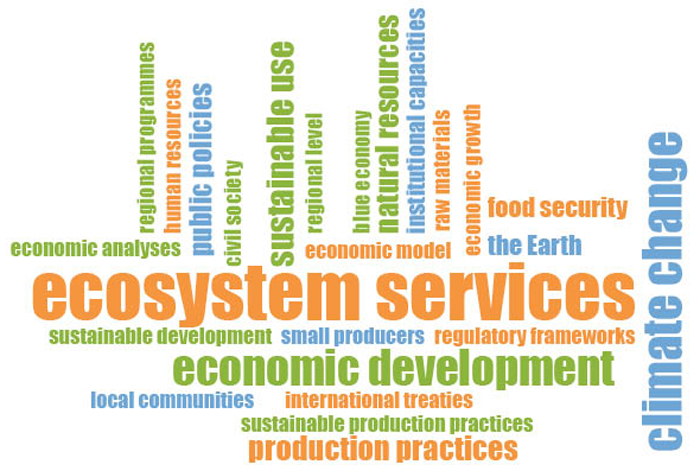
4B. Word cloud of the concepts most mentioned by high-level experts interviewed on biodiversity mainstreaming issues to which ECLAC can contribute
(N= 14)
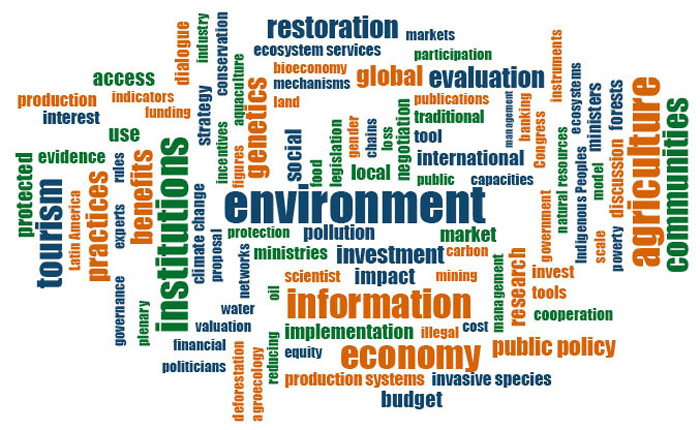
Source: Prepared by ECLAC.
Notes: 4A: The open-ended question (in a survey conducted in the second quarter of 2022) was to give examples of gaps in biodiversity-related challenges (issues that receive little or no institutional attention) in Latin America and the Caribbean where ECLAC can contribute. 4B:Issues mentioned (in interviews conducted in June and July, 2022) on which ECLAC can contribute to the mainstreaming of biodiversity.
ECLAC is also able to bring together sectors and actors that do not usually work on the environment, such as planning, finance, trade and statistics, among others. It is precisely this group of actors and sectors that are most closely related to the indirect causes or underlying drivers of biodiversity loss and environmental degradation, meaning economic, demographic, governance and institutional development, technological, and cultural drivers, those least addressed by governments. One of the lessons learned from the COVID pandemic is the need for a State that coordinates at all levels of government and with society as a whole, since conditions will improve with a proactive public sector that is open to public-private dialogue and also to intra- and intersectoral dialogue (Catacora and others, 2022).
We end this special issue by highlighting that the commitments made at the fifteenth session of the Conference of the Parties of the Convention on Biological Diversity provide excellent opportunities for the region to catalyse the transformation proposed from different perspectives at different forums and scales, but on which there is consensus that common objectives are needed for maximizing individual and collective multidimensional well-being in order to make systemic changes to productive, economic and financial systems. It is widely accepted that well-being must be measured and evaluated in a comprehensive manner —beyond the economic success or failure reported by GDP— and that the idea of development itself has evolved with the integration of social and environmental justice (Harris and others, 2023). It has also been posited that countries that mismanage nature are more vulnerable to economic crises (World Bank, 2021b). Latin America and the Caribbean is a repository of countless positive experiences and good practices that link the three dimensions of sustainable development, and therefore possesses a relevant biocultural foundation based upon which enabling conditions can be strengthened for the implementation of the Kunming-Montreal Framework.
Bibliography
Alvarado, V., M. Tambutti and A. Rankovic (2022), “Experiences in Latin America and the Caribbean with mainstreaming biodiversity in the productive, economic and financial sectors”, Project Documents (LC/TS.2022/206), Santiago, Economic Commission for Latin America and the Caribbean (ECLAC).
Bernstein, J. and others (2021), Strengthening Equity in the Post-2020 Global Biodiversity Framework, International Institute for Environment and Development (IIED).
Catacora-Vargas. G. and others (2022), “Enfoques y prácticas de gobernanza en América Latina y el Caribe para el cambio transformativo a favor de la biodiversidad”, Project Documents. (LC/TS.2021/203), Santiago, Economic Commission for Latin America and the Caribbean (ECLAC).
CBD (Convention on Biological Diversity) (2022a), “COP15: Nations Adopt Four Goals, 23 Targets for 2030 In Landmark UN Biodiversity Agreement | Convention on Biological Diversity (cbd.int)”.
____(2022b), Kunming-Montreal Global Biodiversity Framework [online] https://www.cbd.int/doc/decisions/cop-15/cop-15-dec-04-es.pdf.
____(2020), Global Biodiversity Outlook 5 (GBO-5), Montreal.
____(2012), “About the Convention” [online] https://www.cbd.int/intro/
____(2011), “Strategic Plan for Biodiversity 2011-2020, including Aichi Biodiversity Targets” [online] https://www.cbd.int/sp/.
Dasgupta, P. (2021), The Economics of Biodiversity: The Dasgupta Review, London, HM Treasury.
ECLAC (Economic Commission for Latin America and the Caribbean) (2023), Iberoamérica: espacio de oportunidades para el crecimiento, la colaboración y el desarrollo sostenible (LC/TS.2023/33), Santiago.
____(2020), Building a New Future: Transformative Recovery with Equality and Sustainability (LC/SES.38/3-P/Rev.1), Santiago.
GEF (Global Environment Facility) (2016), Biodiversity Mainstreaming in Practice: A Review of GEF Experience, Washington, D.C.
Gjerde, K. and others (2022), “High seas treaty within reach”, Science, vol. 377.
Global Youth Biodiversity Network (2016), CBD in a Nutshell [online] https://www.gybn.org/resources/guidebook.
Harris, E. and others (2023), Setting a path towards new economics for sustainable development: an overview, United Nations Economist Network [online] https://www.un.org/sites/un2.un.org/files/nesd_overview_20_march.pdf.
Huntley, B.J. and K.H. Redford (2014), Mainstreaming biodiversity in Practice: a STAP advisory document. Global Environment Facility, Washington, D.C.
IISD (International Institute for Sustainable Development) (2022), Earth Negotiations Bulletin, vol. 9, Nº 796 [online] enb.iisd.org/un-biodiversity-conference-oewg5-cbd-cop15.
IPBES (Intergovernmental Science-Policy Platform on Biodiversity and Ecosystem Services) (2019), “Summary for policymakers of the global assessment report on biodiversity and ecosystem services of the Intergovernmental Science-Policy Platform on Biodiversity and Ecosystem Services” [online] https://www.ipbes.net/system/tdf/ipbes_7_10_add-1-_advance_0.pdf?file=1&type=node&id=35245.
____(2018), The regional assessment report on biodiversity and ecosystem services for the Americas. J. Rice y otros (eds.), Bonn, IPBES Secretariat.
IPBES/IPCC (Intergovernmental Science-Policy Platform on Biodiversity and Ecosystem Services/Intergovernmental Panel on Climate Change) (2021) “IPBES-IPCC co-sponsored workshop biodiversity and climate change workshop report” [online] https://www.ipbes.net/sites/default/files/2021-06/20210609_workshop_report_embargo_3pm_CEST_10_june_0.pdf.
IUCN (International Union for Conservation of Nature and Natural Resources) (2023), High Time for the High Seas [online] https://www.iucn.org/story/202302/high-time-high-seas.
Lehm, Z., K. Lara and T. Solares (2017), Ingresos económicos en hogares de la TCO TACANA I, La Paz, Wildlife Conservation Society (WCS)/Consejo Indígena del Pueblo Tacana (CIPTA).
Mazzucato, M. (2022), Transformational change in Latin America and the Caribbean: A mission-oriented approach (LC/TS.2022/150), Santiago, Economic Commission for Latin America and the Caribbean (ECLAC).
Noack, F. and others (2015), “Responses to weather and climate: a cross-section analysis of rural incomes”, Policy Research Working Paper, Nº 7478, World Bank.
PEW Charitable Trusts/SYSTEMIQ (2020), Breaking the Plastic Wave: A comprehensive assessment of pathways towards stopping ocean plastic pollution..
Sánchez, J. (2019) (coord.), Recursos naturales, medio ambiente y sostenibilidad: 70 años de pensamiento de la CEPAL, ECLAC Books, No. 158 (LC/PUB.2019/18-P), Santiago, Economic Commission for Latin America and the Caribbean (ECLAC).
UNDP (United Nations Development Programme) (2023), To achieve the commitments of the Global Biodiversity Framework, local action must take centre stage [online] https://www.undp.org/blog/achieve-commitments-global-biodiversity-framework-local-action-must-take-centre-stage.
____(2016), Latin America and the Caribbean: A Biodiversity Super Power.
UNEP (United Nations Environment Programme) (2020), Measuring progress - The environmental dimension of the SDGs in Latin America and the Caribbean, Panama City.
UNEP (United Nations Environment Programme) and others (2019), Biodiversity and the 2030 Agenda for Sustainable Development: Policy Brief, Nairobi.
UNEP Finance Initiative/Global Canopy (2020), Beyond ‘Business as Usual’: Biodiversity targets and finance. Managing biodiversity risks across business sectors, Cambridge.
United Nations (2020), Sustainable Development Goals. Take action for the Sustainable Development Goals [online] https://www.un.org/sustainabledevelopment/sustainable-development-goals/.
WEF (World Economic Forum) (2022), The Global Risk Report 2022 [online] https://www3.weforum.org/docs/WEF_The_Global_Risks_Report_2022.pdf.
____(2021), The Global Risk Report 2021 [online] https://www3.weforum.org/docs/WEF_The_Global_Risks_Report_2021.pdf.
____(2020a), The Global Risk Report 2020 [online] https://www3.weforum.org/docs/WEF_Global_Risk_Report_2020.pdf.
____(2020b), Nature Risk Rising: Why the crisis engulfing nature matters for business and the economy [online] https://www3.weforum.org/docs/WEF_New_Nature_Economy_Report_2020.pdf.
____(2019), The Global Risk Report 2019 [online] https://www3.weforum.org/docs/WEF_Global_Risks_Report_2019.pdf.
____(2018), The Global Risk Report 2018 [online] https://www3.weforum.org/docs/WEF_GRR18_Report.pdf.
____(2017), The Global Risk Report 2017 [online] https://www3.weforum.org/docs/GRR17_Report_web.pdf.
____(2016), The Global Risk Report 2016 [online] https://www3.weforum.org/docs/GRR/WEF_GRR16.pdf.
____(2015), The Global Risk Report 2015 [online] https://www3.weforum.org/docs/WEF_Global_Risks_2015_Report15.pdf.
____(2014), The Global Risks Report 2014 [online] https://www3.weforum.org/docs/WEF_GlobalRisks_Report_2014.pdf.
____(2013), The Global Risks Report 2013 [online] https://www3.weforum.org/docs/WEF_GlobalRisks_Report_2013.pdf.
____(2012), The Global Risks Report 2012 [online] https://www3.weforum.org/docs/WEF_GlobalRisks_Report_2012.pdf.
World Bank (2021a), The Economic Case for Nature. A Global Earth-Economy Model to Assess Development Policy Pathways, Washington, D.C.
____(2021b), The Changing Wealth of Nations 2021: Managing Assets for the Future. Executive Summary booklet, Washington, DC.
WWF (2020), Living Planet Report 2020 - Bending the curve of biodiversity loss, R.E.A. Almond, M. Grooten and T. Petersen (eds), Gland.